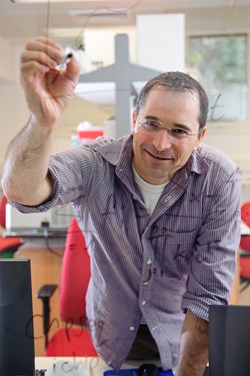
Immunotherapies, which harness the immune system to fight disease, are revolutionizing treatments for many types of cancer. Having made significant breakthroughs in the field, Weizmann Institute of Science researchers are now exploring ways to apply immunotherapy to conditions other than cancer, including neurodegenerative diseases like Alzheimer’s. Prof. Ido Amit of the Department of Immunology is advancing this research by developing sophisticated tools and technologies to investigate the immune system’s role in neurodegenerative diseases.
“What we’ve discovered in our research is that the immune system is heavily involved in continuously protecting us from damage in our brains,” says Prof. Amit. “We want to gain a better understanding of the role of the immune system in Alzheimer’s disease – in particular, the cells and pathways that are involved and how we can develop new immunotherapies to reactivate the immune system to nurture the brain.”
In the past, researchers theorized that suppressing the immune system would treat neurodegenerative diseases. In fact, found Prof. Amit, the opposite was true.
Prof. Amit’s team – which includes experts in genomics, immunology, biochemistry, computer science, and physics – develops state-of-the-art technologies and analytics to study the genes that control the immune system’s activity in the brain. He has developed a close collaborative partnership with neuroimmunologist Prof. Michal Schwartz in the Institute’s Department of Neurobiology, and together they have made significant advances toward understanding the role of the immune system in Alzheimer’s – even identifying potential targets for therapy.
In the past, some researchers theorized that suppressing the immune system could treat certain neurodegenerative diseases. But a study by Profs. Amit and Schwartz demonstrated the opposite: reactivating, or boosting, the immune system might be a far better strategy. In a mouse model of Alzheimer’s disease, they found protective immune cells called microglia that are involved in protecting cognitive function. The microglia “cleanse” the brain of toxic materials, including the tangles of beta-amyloid plaques that are a hallmark of Alzheimer’s.
Prof. Amit aims to reactivate the immune system to nurture the brain – thus helping fight Alzheimer’s disease.
“When we reactivated the immune system in the mice, it reversed their Alzheimer’s-like disease,” says Prof. Amit. “These are remarkable findings and they give us a lot of hope that we’re on the right track to understand the underlying mechanisms of the disease – and perhaps even stop it and reverse it.”
In another study, published in the journal Science, Prof. Schwartz teamed with Prof. Amit to test her theory that cognitive decline over the years may be connected not only to one’s chronological age, but also to one’s “immunological age” – that is, changes in immune function over time might contribute to changes in brain function that are not necessarily in step with the count of one’s years.

Prof. Schwartz’s group had already shown that the immune system plays a key role in both maintaining the brain’s normal functioning and healing it after injury, and were the first to show that this brain-immune interaction occurs across an interface called the choroid plexus.
Building on that research, the scientists used gene-sequencing technology developed by Prof. Amit’s lab to map changes in gene expression in 11 different organs, including the choroid plexus, in both young and aged mice. Identifying and comparing pathways involved in the aging process, the researchers uncovered a unique “signature of aging” that exists solely in the choroid plexus. One of the main elements of this signature was interferon beta – a protein that the body normally produces to fight viral infection, but which appears to have a negative effect on the brain. When an antibody that blocks interferon-beta activity was administered to the older mice, their cognitive abilities were restored … as was their ability to form new brain cells.
The scientists have also identified this unique signature in elderly human brains. Their findings may lead to treatments that can slow – or even reverse – cognitive decline in older people.
Findings by Prof. Amit and his colleagues may lead to treatments that can slow – or even reverse – cognitive decline in older people.
Profs. Amit and Schwartz also tackled an open question: What is the role of the brain’s own immune cells, the microglia? Their findings provide a compelling possible approach to treating Alzheimer’s. Using one of Prof. Amit’s technological advances ‒ a “genetic microscope” that fully sequences the genetic material and function of individual cells ‒ the team sequenced the RNA content of each and every immune cell in the brains of mice at different stages of an Alzheimer’s-like condition.
In the affected mice, Profs. Amit and Schwartz identified unique microglial cells that gradually changed as the disease progressed. Because these cells only appear in Alzheimer’s disease, they are new potential targets in the search for a therapy.
Prof. Amit’s work is changing the way we look at genetics, the immune system, and neurodegenerative disease. “The collaborative spirit at the Weizmann Institute is something that you don’t find in many places,” he says. “There’s a great generosity and curiosity here.”
Prof. Ido Amit’s research is supported by the Helen and Martin Kimmel Award for Innovative Investigation; the Sagol Institute for Longevity Research; the Kekst Family Institute for Medical Genetics; the Thompson Family Foundation Alzheimer's Research Fund; the Adelis Foundation; the Steven B. Rubenstein Research Fund for Leukemia and Other Blood Disorders; the Rising Tide Foundation; Richard & Jacqui Scheinberg; the Anita James Rosen Foundation; the Lowy Foundation; the Bill & Patricia Ritchie Foundation Limited; the Wolfson Family Charitable Trust; the Estate of Simon Saretzky; and the Estate of Arthur Rath. He is the incumbent of the Eden and Steven Romick Professorial Chair.
